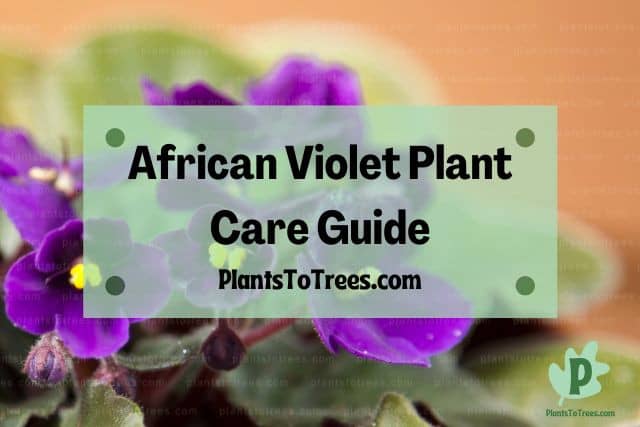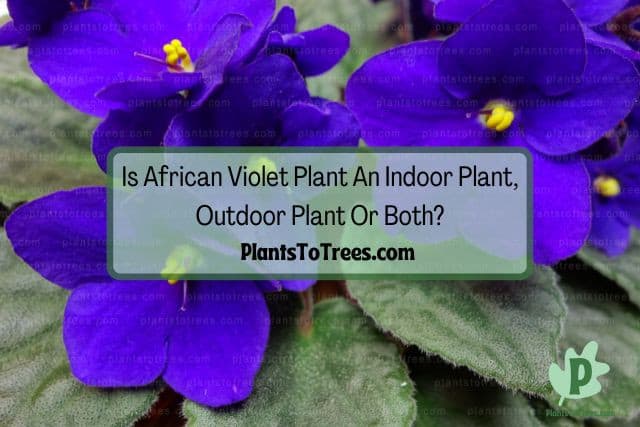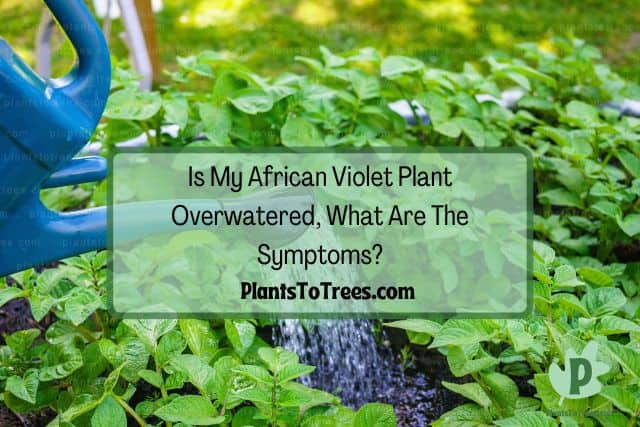African violets are an extremely popular houseplant and for good reason. These plants produce stunningly vibrant blooms in a wide array of colors. The African violet plant blooms several times, so it isn’t a one and done type of plant. They are also compact in size, which makes them ideal for indoor gardeners with limited space. Unfortunately, these plants get a bad rap due to their somewhat fussy nature. Thankfully, with the right African violet plant care guide, you will see nothing but success with this plant.

An African violet plant care guide helps to ensure you are giving the plant the best care possible. This means providing the plant with the right amount of water, light, and fertilizer.
African violets need an abundance of bright indirect light. Without the right amount of light, the plant won’t be able to produce the stunning blooms that are so desired. They also need to grow in slightly acidic soil that is light and allows for water to drain easily through it.
African violet plants also grow best in temperatures between 65 and 80 degrees Fahrenheit. Anything below 65 degrees and you run the risk of injuring the plant. These plants also do well when they have a humidity level of about 80%. They should also be kept away from areas where temperature fluctuations, such as in rooms or near objects that can cause sudden drafts.
Other Names Of African Violet Plant
The African violet plant is most known by that name, but does it also have other aliases that some people call it?
The African violet plant is not well known by any other name. Some people simply call it a violet, even though the African violet is not a true violet plant. The African violet’s scientific name is Saintpaulia, and it includes 10 species of flowering plants.
Frost Tolerance And USDA Hardiness Zones Of African Violet Plant

While it doesn’t matter what zone you live in if you are growing the plant indoors, some people would prefer to plant the African violet outside where it can get fresh air. However, before you start digging the hole, make sure to familiarize yourself with the frost tolerance and USDA hardiness zone requirements for the African violet plant.
The African violet plant is not frost tolerant, and is only hardy in USDA plant hardiness zones 11 and 12. Because of this limited area, most people are forced to grow the African violet indoors as a houseplant.
How Many Hours Of Sunlight Does African Violet Plant Need?
All plants need sunlight, even if it’s just a little. Sunlight is needed for plants to grow strong and healthy. However, too much of it can leave your African violet plant looking worse for wear. That is why it’s important to know how many hours of sunlight the African violet plant needs.
The African violet plant needs 12 to 16 hours of sunlight every day. This can sometimes be difficult to provide naturally. Because of this, some indoor gardeners choose to supplement the lighting requirements with fluorescent lights.
One of the most common reasons as to why African violet plants don’t bloom is not providing them with enough sunlight. Since they do require so much sunlight every single day, it can be pretty difficult to ensure they get this amount. Grow lights or even turning a light on in the room where the plant is growing will help ensure the African violet gets the light it needs.
If you do decide to use fluorescent lights, make sure the light fixtures are about 8 to 10 inches above the African violet plants. Putting the lights too close can burn and scorch the plants.
African Violet Plant Needs Direct Or Indirect Sunlight?
Not all sunlight is the same, and provisioning the wrong kind for the African violet can be just as bad as not giving it any sunlight.
African violets need indirect sunlight, and they should never be placed in direct light. Direct sunlight will damage the plant, causing burnt spots on the foliage. It can also lead to wilting and stunted growth. Nothing good will come from putting your African violet plant in direct sunlight.
Is African Violet Plant An Indoor Plant, Outdoor Plant Or Both?

The African violet plant is a versatile flower that can provide you with years of joy, and there are some things you can do to help prolong its life. One way to do this is to ensure they are growing in the right conditions. But are these conditions found indoors or outdoors?
The African violet plant is more of an indoor plant, but may be able to grow outdoors in the right USDA plant hardiness zones, which are zones 11 and 12. Most gardeners select to grow the plant indoors since it can be difficult to keep the plant thriving outdoors.
What Are The Indoor Lighting Requirements For An African Violet Plant?
One of the challenges to growing any plant indoors is to ensure it gets the right amount of light it needs. Without the right amount of light, the plant will experience stunted growth and may even fail to bloom.
Bright, indoor sunlight is needed for African violet plants. An east or north facing window typically provides the plant with the much needed light. It is vital, however, that you keep the plant out of direct sun.
Make sure to rotate the plant once a week so that all of its leaves get access to the sun’s rays. In the winter months when the amount of sunlight has diminished, you may have to supplement the African violet plant’s light with grow lights.
What Are The Outdoor Lighting Requirements For An African Violet Plant?
While African violet plants can grow outdoors, it can be extremely difficult to get them to survive. You will first have to reside in USDA plant hardiness zones 11 or 12. If you do, you can try your hand at growing these flowers outside if you can give them the right lighting requirements.
No matter where you grow the African violets, it needs bright light that is indirect. This means growing the plant in a bright spot that has filtered or dappled sunlight. You also want to ensure the plant is protected from high winds and hard rain.
Because growing African violets outside is so difficult, most people choose to have this flower as a houseplant. That doesn’t mean, however, that you cannot take the plant outside on warm days. Just make sure you bring the plant back indoors before temperatures go below 65 degrees.
What Soil Requirements Does African Violet Plant Need?

African violet plants need the same type of soil as most other houseplants, which is well-draining soil that isn’t compact. But that isn’t the only aspect of the soil you should worry about when growing African violet plants.
African violet plants need light and airy soil that is slightly acidic. A good pH level for African violet soil is 6.0 to 6.5. Never let the plant grow in soil that is compact, since this will only increase the chance of root rot.
A potting soil designed for indoor plants will typically work fine for these flowers. However, there are several different brands that currently offer soil mixtures designed specifically for African violets. This is an option if you want something tailored for your plants.
How Much Water Does African Violet Plant Need?
Water helps to keep plants, such as African violets, hydrated and growing well. If you’re not providing the plant with the right amount of water, however, you are playing roulette with its health.
African violet plants need between 1 and 2 inches of water every week. This amount can fluctuate depending on several factors. If you’re unsure as to how much water it needs, start at 1 inch per week and then work your way up to 2 inches per week if needed.
To help determine whether or not your plant needs water, check the top few inches of soil. If it feels damp, then wait a few days before checking again. Once the soil starts to feel dry, then its time to hydrate your African violet plant.
Is My African Violet Plant Overwatered, What Are The Symptoms?

The symptoms of an overwatered African violet are the same as other plants that have received too much water. Knowing what these symptoms are can help you quickly identify the problem before it gets out of hand.
African violet plants that have been overwatered will have soggy soil, and limp, mushy, or soft leaves and stems. You may also start to notice an unpleasant musty or mildew-like odor coming from the plant. If the overwatering isn’t corrected, root rot will set in.
Once the African violet has developed root rot, trying to get rid of it can be a chore. The plant will need to be removed from its pot, all the soil removed, and any dead or diseased roots cut off. The pot will need to be cleaned and sanitized before repotting the African violet and fresh potting soil will need to be added.
We at Plants To Trees first published this article on October 28, 2022. Copyright protected.
Is My African Violet Plant Underwatered, What Are The Symptoms?
The symptoms of an underwater African violet plant are easy to spot if you know what to look for.
When an African violet plant is underwatered, the top of the soil will feel dry and crumbly. The leaves will also feel dry and crispy, and the plant’s stature may seem wilted. It may also experience leaf and petal drop as well.
If the plant is severely underwatered, simply pouring water on top of the soil won’t work. The plant will need to be submerged in a bucket of water and allowed to soak for about 30 minutes. After this time, remove the pot from the bucket and allow the excess water to drain out of the African violet’s pot.
How Much Fertilizer Does African Violet Plant Need?

Fertilizer is an important aspect of gardening, and it is not uncommon for gardeners to have multiple types of fertilizer for the various plants they are growing. Unfortunately, many people are unaware that some houseplants may also need feeding.
African violet plants will need feed with a 3-3-3 liquid fertilizer. This helps to encourage growth, promote flower blooming, and strengthens the plant’s root system. The fertilizer will need to be applied every 4 to 6 weeks during the plant’s active growing period, which is in the spring and summer.
Before you feed the African violet plant, make sure to moisten the soil and then apply the liquid fertilizer. Make sure to also follow the application instructions located on the back of the fertilizer bottle for best results.
African Violet Plant Diseases To Be Aware Of
Indoor houseplants typically don’t have to deal with as many diseases and problems as outdoor plants. But that doesn’t mean that they are immune to all diseases. There are actually several serious diseases that can affect African violet plants, and knowing what they are is the first step in protecting your plants.
African violet plants are no stranger to diseases, and there are several different types that can attack this plant. The diseases affecting the African violet plant are bacterial blight, botrytis blight, phytophthora crown rot, powdery mildew, pythium root rot, rhizoctonia crown rot, and ring spots.
Bacterial blight is caused by the pathogen Erwinia chrysanthemi, and it occurs when environmental conditions are favorable for the bacteria to grow. These conditions include high levels of humidity combined with high temperatures. Bacterial blight presents itself as black or reddish brown rotting areas on the crown and roots of the plants. The leaf stems may also appear greasy. Treatment for this disease includes removing and destroying all infected leaves and applying fungicide to the plant.
Botrytis blight is caused by the fungus Botrytis cinerea, which occurs when there are high levels of humidity and little airflow. When your plant is infected with botrytis blight, it will develop water-soaked spots on the leaf stems, which will then spread to the leaf blade. Control this blight by pruning and destroying all infected parts of the African violet. Make sure you disinfect the pruning shears with a diluted bleach solution between cuts to help stop the spread of the disease. Additionally, apply a fungicide to the African violet plants to aid in controlling the fungal disease.
The article owner is Plants To Trees dot Com and this article was first published on October 28, 2022.
Phytophthora crown rot is a soil-borne fungal disease that can occur when soil temperatures reach above 60 degrees paired with a high level of moisture in the soil. Affected roots and crowns will look water-soaked, and as the disease progresses, it will spread to leaf blades and stems. Control crown rot by removing all infected plant parts and then applying a fungicide.
Powdery mildew is not nearly as difficult to get rid of as some of the other fungal diseases, but you should still take it seriously if it affects your African violet plant. This disease occurs when it is warm and dry combined with a high level of humidity. Think of the warm days and cooler nights that typically occur in spring and early summer. This time is when powdery mildew is the most prevalent. Poor air circulation and little sunlight will also encourage the growth of this fungal disease.
Like its name suggests, powdery mildew causes a whitish or gray powder-like substance to form on the leaves and flowers. Treatment of powdery mildew requires applying a fungicide to the plant. Make sure to also correct any airflow issues you may be having that can promote its growth.
Pythium root rot is another fungal disease that can attack African violet plants. This disease is caused by poor soil drainage or overwatering. Infected plants will start to wilt and turn yellow, and their roots will become dark brown. Treatment for pythium root rot will require correcting the excessive moisture problem, repotting the African violet in fresh soil and a sanitized pot, and applying a fungicide to the plant.
Rhizoctonia crown rot is a common root disease that is caused by a soil-borne fungus. African violets that are allowed to sit in soggy and heavy soils are more susceptible to this disease than plants that grow in well-drained and light soils. This crown rot can result in your African violet plants wilting, discoloring, and dying. Unfortunately, crown rot is almost always fatal in African violets.
Ring spots are one of the least serious diseases that can affect African violet plants. In fact, this issue isn’t really even a disease per say, and it only occurs when water comes in contact with the leaves. When water does touch the plant’s foliage, bleached white or yellow ring will form on the leaves. While there are no real treatments for this problem, making sure water doesn’t touch the foliage will prevent ring spots from occurring. Some gardeners also recommend using water that is at room temperature to help reduce these spots.
Are There Different Types Of African Violet Plants?

For people interested in growing African violet plants, you may be surprised to learn that there are several different types available. While the most popular African violet variety is the Little Maya, which features crimson red blooms. It was first introduced in 1997 and quickly became a favorite of indoor gardeners. But Little Maya isn’t the only type of African violet plant out there.
There are several different types of African violet plants, and each has its own unique characteristics. Some grow a little taller than others, while some have different colored blooms. One of the most common differences between the varieties is the flower shape.
These varieties include flower shapes such as single, frilled, star, cup, semi-double, double, fluted, and wasp. No matter what the variety, however, they all have about the same growing requirements.
How To Propagate African Violet Plant
African violets are propagated by leaf cutting, which can then be rooted in water or soil. The entire process is relatively simple and can provide you with multiple new African violet plants to keep for yourself or give away to friends or family.
To propagate African violet plants, you will first need to remove and trim a fresh leaf, cut the leaf stem at an angle, and then plant it in soil or water. After about 12 weeks, plantlets will begin to develop. Once they appear above the soil, you can separate each one and plant it into its own pot.
Let’s break down the process of propagating this plant into more detailed instructions. Find a healthy, fresh leaf that you will use in the process.
Make sure when you are cutting the leaf from the African violet that you leave about 1 1/2inches of the stem, also called petiole, attached to the leaf. Cut the leaf stem at a 45 degree angle with its cut side facing upward. The cut should be about ½ inch long. Cutting the leaf in this manner will help encourage root and plantlet growth.
Now that you have your leaf blade ready, root it in either a vase of water or a pot filled with an equal mixture of coarse sand or vermiculite. If rooting in soil, water the pot until the mixture is moist but not soggy.
Cover the cutting and pot or vase with clear plastic and secure it with either a rubber band or a piece of tape. You are essentially creating a mini greenhouse around the cutting. Place the pot in a bright area away from direct light and direct heat.
Is an African Violet Plant Toxic To Humans?
Whether a plant is toxic or not is important information that one should know before growing it. This becomes even more important if you have children in the home.
The good news is that the African violet plant is not toxic to humans, which makes it a great houseplant for homes with children. Despite not being toxic, it is still not recommended to allow children or pets to eat this plant.
Is an African Violet Plant Toxic To Dogs?
Houseplants and dogs can pose a serious and frustrating situation. A wide array of plants can threaten the health and even life of your pooch. Because of this threat, many people decide not to keep houseplants, since they would rather be safe than sorry. But what if you didn’t have to choose between your dog and houseplants?
African violet plants are not toxic to dogs, which makes them a safe houseplant to grow. Even if your pooch ate the plant, it shouldn’t cause any dangerous side effects. It could cause an upset stomach and diarrhea, however.
Is an African Violet Plant Toxic To Cats?

Because of the sheer amount of plants that are toxic to cats, it can be difficult for cat lovers to grow indoor plants. This leaves you with the difficult decision of having cats or having houseplants. Thankfully, not all houseplants are dangerous to cats and there are a few that pose no risk to felines. But is the African violet plant one of these plants?
African violet plants are non-toxic to cats, according to the ASPCA. With that said, however, if your cat consumes a large amount of the plant, they may experience an upset stomach or diarrhea.
Related Articles
Tips On Caring For African Violet Flowers
Problems With African Violet Leaves (How to Fix)
PlantsToTrees.com is the owner of this article and we first published this on October 28, 2022.
